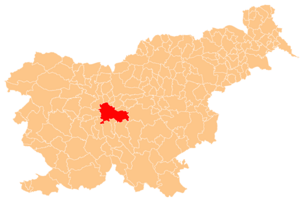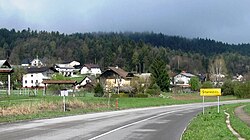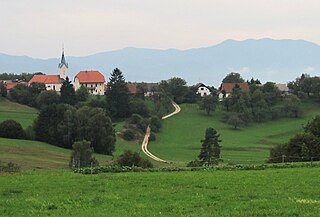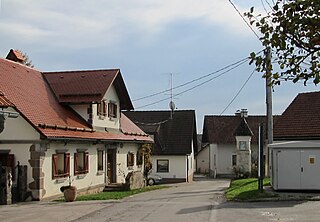| Stanežiče | |
|---|---|
Stanežiče | |
| Coordinates: 46°6′43.44″N14°26′2.9″E / 46.1120667°N 14.434139°E Coordinates: 46°6′43.44″N14°26′2.9″E / 46.1120667°N 14.434139°E | |
| Country | |
| Traditional region | Upper Carniola |
| Statistical region | Central Slovenia |
| Municipality | Ljubljana |
| Area | |
| • Total | 1.84 km2 (0.71 sq mi) |
| Elevation | 337.2 m (1,106.3 ft) |
| Population (2002) | |
| • Total | 670 |
| • Density | 360/km2 (940/sq mi) |
| [1] | |
Stanežiče (pronounced [ˈstaːnɛʒitʃɛ] ; German : Staneschitz [2] ) is a settlement in the City Municipality of Ljubljana in central Slovenia. It lies just northwest of Ljubljana and was part of the traditional region of Upper Carniola. It is now included with the rest of the municipality in the Central Slovenia Statistical Region. [3]

German is a West Germanic language that is mainly spoken in Central Europe. It is the most widely spoken and official or co-official language in Germany, Austria, Switzerland, South Tyrol (Italy), the German-speaking Community of Belgium, and Liechtenstein. It is also one of the three official languages of Luxembourg and a co-official language in the Opole Voivodeship in Poland. The languages which are most similar to German are the other members of the West Germanic language branch: Afrikaans, Dutch, English, the Frisian languages, Low German/Low Saxon, Luxembourgish, and Yiddish. There are also strong similarities in vocabulary with Danish, Norwegian and Swedish, although those belong to the North Germanic group. German is the second most widely spoken Germanic language, after English.

The City Municipality of Ljubljana, also the City of Ljubljana is one of eleven city municipalities in Slovenia. Its center is Ljubljana, the largest and capital city of Slovenia. As of June 2015, its mayor is Zoran Janković.

Slovenia, officially the Republic of Slovenia, is a sovereign state located in southern Central Europe at a crossroads of important European cultural and trade routes. It is bordered by Italy to the west, Austria to the north, Hungary to the northeast, Croatia to the southeast, and the Adriatic Sea to the southwest. It covers 20,273 square kilometers (7,827 sq mi) and has a population of 2.07 million. One of the successor states of the former Yugoslavia, Slovenia is a parliamentary republic and a member of the United Nations, of the European Union, and of NATO. The capital and largest city is Ljubljana.
Contents
The local church is dedicated to Saint James (Slovene : sveti Jakob) and belongs to the Parish of Šentvid. [4] The bell tower was built in 1681, the nave and cloistered presbytery in 1721, and the barrel-vaulted narthex in 1794. The main altar was created by Matevž Tomec in 1856. There are four side altars in the church, dedicated to the Descent from the Cross and Saint Florian (both 1739), and to Saint Peregrine and Saint Lucy (both renovated in 1934). [5]

A church building or church house, often simply called a church, is a building used for Christian religious activities, particularly for Christian worship services. The term is often used by Christians to refer to the physical buildings where they worship, but it is sometimes used to refer to buildings of other religions. In traditional Christian architecture, the church is often arranged in the shape of a Christian cross. When viewed from plan view the longest part of a cross is represented by the aisle and the junction of the cross is located at the altar area.

James, son of Zebedee was one of the Twelve Apostles of Jesus, traditionally considered the first apostle to be martyred.

Slovene or Slovenian belongs to the group of South Slavic languages. It is spoken by approximately 2.5 million speakers worldwide, the majority of whom live in Slovenia. It is the first language of about 2.1 million Slovenian people and is one of the 24 official and working languages of the European Union.


















